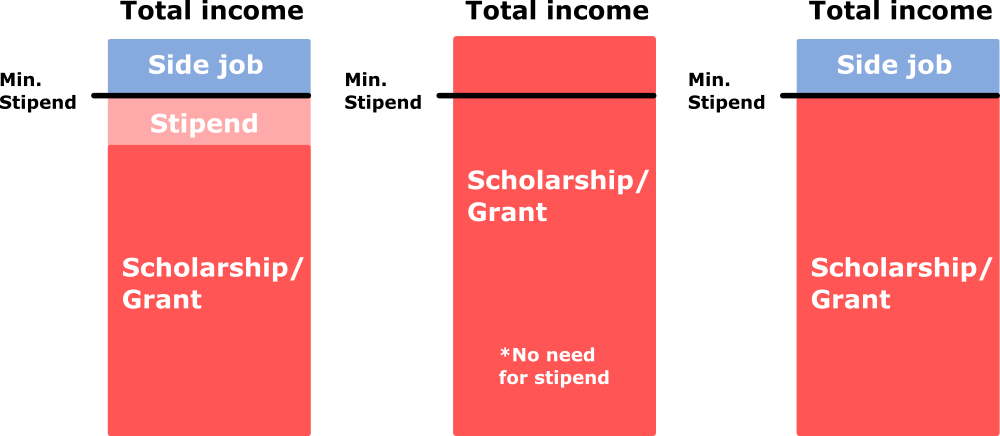You can get your graduate degree without taking a loan. In fact, you can even payoff some or all of the undergraduate student loan. Here is how.
There are three possible sources of income for graduate students in research.
- Scholarship/Grant
- Stipend
- Side-job
And there are two sources of expense.
- Tuition
- Living expense
Let me state the obvious. To have money left over after paying tuition and living expense, you have to: 1) Decrease your expense and/or 2) Increase your income.
How to decrease your expense
There really is no easy trick to this. You just have to ‘live like a student’.
However, a little thing (but not so little in $) I did notice over the years on spending smart is to ‘pack your lunch and coffee’. Buying lunch at work and a two dollar coffee racks up very quickly and high. This may sound silly but the cost of cafeteria lunch and coffee can literally payoff your student loan or give you spending money for other stuff.
I won’t get to more into it since there are many good Youtube videos on how to spend smart.
How to increase your income

Stipend (cannot change)
The research work you do is a genuine contribution to the society. So you get paid by your PI who got paid by the government/industry/private organization. Here is more on how academia works.
The minimum amount is set by your department or institution, and most people get paid close to the minimum amount. Stipend is your base income. This is the amount your school or institution guarantees you for set duration of your study.
Here is a Graduate student salary in Canada on Glass door to gauge what you can expect.
*This info on stipend pertains to US and Canada. Most European countries, work a bit differently. For example in France, Master’s degree is divided into a course section and internship section. You only get paid during the ‘internship’ portion of the degree and only a half of what you would get paid during PhD. PhDs gets paid a stipend comparable to North America. But it is important to note that tuition is only a couple hundreds euros compared to thousands in Canada and thousands to 20,000 in US.
Side job (can change)
Many students work part time during their graduate school. If you are doing graduate school in research this is not a necessity. Your minimum stipend will likely cover most if not all of your living expenses as long as you budget yourself. However, who doesn’t want extra spending money for the weekend or traveling? Side job is really only limited by what part time job you can manage.
Here are academic vs non-academic side job examples I have seen:
Non-academic:
Coffee shop
Fast food/Restaurant
Cashier
Tutor
Academic:
Teaching assistant
Exam invigilator (temporary)
I must remind you, however, that part time will take away energy and time you could spend on your studies. And I personally have managed to payoff much of my undergrad loan during my Masters without working part time. My take on this is that side job is only necessary if have very specific financial goals and needs.
Scholarship/Grant (can change)
Here is where you can make a long term difference in your total income.
Depending on which country, region, and institution you are in, but there are bound to be scholarship and grant opportunities around you. Let’s take Canada for an example. In Canada, there are four levels of salary funding sources for students doing graduate research. This can be generalized to US and many European countries.
First, there is Federal level funding such as CIHR, NSERC, and SSHRC. This is the type of funding that is the most competitive and gives out the largest amount. Most times, more than your minimum stipend. Second, there is provincial (state) level of funding such as FRQ in Quebec and BCKDF in British Columbia. This is fairly competitive and gives amount that usually equals to the minimum stipend. Third, each university or research center has one form of scholarship/bursary/grant or another. Again, pays about the same as minimum stipend. Fourth, a private source. This can be coming from an industry partner of the project you may be taking on or can be private foundation supporting a cause. For example, a joint effort with a pharmaceutical company and the lab or Gates foundation funding a research project. The sum varies significantly going over minimum stipend rate by far or much much less.
Here is the interesting bit. Not all, but some scholarships/grants can be combined. A lot of times when you receive a funding there is a clause that says you cannot receive any other funding. However, some allows you to receive other funding on top of it or ‘stack-able’.
So the scholarship/grant strategy is:
- Receive scholarship that gives larger amounts.
- Receive fundings that are ‘stack-able’.
Last bit of important information: regarding money coming from scholarships/grants, your PI may have the authority to take the excess amount beyond the minimum stipend and put that into the lab or towards paying for your project’s costs. So do discuss with your PI and have an understanding. Most times, they are sympathetic towards the student’s financial situations.

